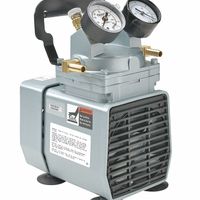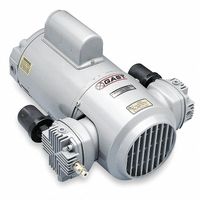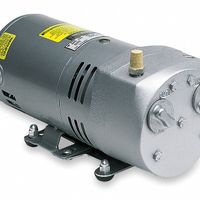Call +(254) 703 030 000 / 751 483 999 / 721 704 777
- Home
- Pneumatics
- Air Compressors Vacuum Pumps Blowers
- Combination Compressor Vacuum Pumps
.....Read More
Frequently Asked Questions
What are the main applications of combination air compressor and vacuum pumps?
Combination air compressor and vacuum pumps are versatile devices used in various industries due to their ability to perform dual functions—compressing air and creating a vacuum. Here are the main applications:
1. **Medical and Dental Equipment**: These pumps are crucial in medical and dental settings for suction applications, such as in surgical procedures and dental cleanings, where both compressed air and vacuum are needed.
2. **Packaging Industry**: In packaging, they are used for vacuum sealing and forming, ensuring products are securely packed and preserved. The compressed air function aids in the operation of pneumatic tools and machinery.
3. **Laboratory Applications**: Laboratories use these pumps for filtration, aspiration, and degassing processes. They are essential in maintaining controlled environments and handling sensitive materials.
4. **Food and Beverage Industry**: They are employed in processes like bottling, canning, and vacuum packaging to extend shelf life and maintain product quality. Compressed air is also used for cleaning and operating pneumatic systems.
5. **Printing Industry**: In printing, these pumps help in paper handling, ensuring sheets are properly aligned and fed into machines. The vacuum function assists in holding paper in place, while compressed air aids in drying inks.
6. **HVAC Systems**: They are used in heating, ventilation, and air conditioning systems for controlling air flow and maintaining pressure levels, ensuring efficient system operation.
7. **Manufacturing and Automation**: In manufacturing, they power pneumatic tools and machinery, and in automation, they are used for pick-and-place operations, where vacuum is needed to lift and move objects.
8. **Environmental and Waste Management**: These pumps are used in air sampling and pollution control systems, where both vacuum and compressed air are necessary for testing and treatment processes.
9. **Aerospace and Automotive**: In these industries, they are used for testing components, operating pneumatic tools, and in assembly lines where precision and reliability are critical.
How do combination air compressor and vacuum pumps work?
Combination air compressor and vacuum pumps operate by utilizing a single mechanism to perform both compression and vacuum functions. These devices typically use a piston or rotary vane system to achieve the desired outcomes.
In a piston-based system, the device contains a cylinder with a piston that moves back and forth. During the compression phase, the piston moves downward, drawing air into the cylinder through an intake valve. As the piston moves upward, the air is compressed and pushed out through an exhaust valve, creating compressed air. For the vacuum function, the same piston movement creates a low-pressure area by drawing air out of a connected chamber, effectively creating a vacuum.
In a rotary vane system, a rotor with multiple vanes is housed within a cavity. As the rotor spins, the vanes slide in and out, maintaining contact with the cavity walls. This movement creates expanding and contracting volumes. For compression, air is drawn in through an inlet, trapped between the vanes, and compressed as the volume decreases, then expelled through an outlet. For vacuum, the process is reversed, with air being drawn out of a connected chamber, reducing the pressure and creating a vacuum.
These combination units are equipped with valves and controls to switch between compression and vacuum modes, allowing them to perform dual functions efficiently. They are commonly used in industries where both compressed air and vacuum are needed, such as in packaging, medical equipment, and laboratory applications. The ability to perform both functions with a single unit offers space-saving and cost-effective solutions.
What are the advantages of using a combination unit over separate compressor and vacuum pump systems?
A combination unit that integrates both a compressor and a vacuum pump offers several advantages over using separate systems:
1. **Space Efficiency**: A combination unit typically requires less physical space than two separate systems. This is particularly beneficial in environments where space is limited, such as small workshops or laboratories.
2. **Cost Savings**: Purchasing a single combination unit can be more cost-effective than buying two separate machines. Additionally, maintenance and operational costs are often lower, as there is only one system to service and repair.
3. **Simplified Installation**: With a combination unit, installation is generally more straightforward, requiring fewer connections and less complex setup. This can reduce installation time and associated labor costs.
4. **Energy Efficiency**: Combination units are often designed to optimize energy use, potentially leading to lower energy consumption compared to operating two separate systems. This can result in reduced utility bills and a smaller environmental footprint.
5. **Integrated Control Systems**: Many combination units come with integrated control systems that allow for easier monitoring and management of both functions. This can enhance operational efficiency and simplify user interaction.
6. **Reduced Noise Levels**: A single, well-designed combination unit may produce less noise than two separate machines, contributing to a quieter work environment.
7. **Enhanced Reliability**: With fewer components and connections, combination units can offer increased reliability and reduced risk of system failure.
8. **Streamlined Maintenance**: Maintenance tasks are simplified as there is only one system to service. This can lead to reduced downtime and lower maintenance costs.
9. **Versatility**: Combination units can be used in a variety of applications, providing flexibility for businesses that require both compressed air and vacuum capabilities.
Overall, combination units offer a practical and efficient solution for businesses looking to optimize space, cost, and operational efficiency.
What maintenance is required for combination air compressor and vacuum pumps?
Maintenance for combination air compressor and vacuum pumps involves several key tasks to ensure optimal performance and longevity:
1. **Regular Inspection**: Conduct routine checks for any signs of wear, damage, or leaks in hoses, fittings, and seals. Inspect the belts for tension and wear, and replace them if necessary.
2. **Lubrication**: Ensure that all moving parts are adequately lubricated. Check the oil levels regularly and change the oil according to the manufacturer's recommendations to prevent friction and overheating.
3. **Filter Maintenance**: Clean or replace air intake filters regularly to prevent dust and debris from entering the system, which can cause blockages and reduce efficiency.
4. **Drain Condensate**: Regularly drain condensate from the air receiver tank and any moisture traps to prevent water accumulation, which can lead to corrosion and damage.
5. **Check Vacuum Pump Oil**: For oil-sealed vacuum pumps, monitor the oil level and quality. Change the oil as per the manufacturer's guidelines to maintain proper sealing and cooling.
6. **Inspect Valves and Gaskets**: Check all valves and gaskets for proper operation and seal integrity. Replace any faulty components to prevent leaks and ensure efficient operation.
7. **Monitor Performance**: Keep an eye on the pressure and vacuum levels to ensure they are within the specified range. Any significant deviation might indicate a problem that needs addressing.
8. **Clean Cooling Systems**: Ensure that the cooling systems, such as fans and heat exchangers, are clean and unobstructed to prevent overheating.
9. **Electrical Components**: Inspect electrical connections and components for signs of wear or damage. Tighten any loose connections and replace damaged wires or components.
10. **Record Keeping**: Maintain a detailed log of all maintenance activities, including dates, parts replaced, and any issues encountered, to track the equipment's health and anticipate future maintenance needs.
How do I choose the right combination air compressor and vacuum pump for my needs?
To choose the right combination of air compressor and vacuum pump, consider the following factors:
1. **Application Requirements**: Determine the specific tasks you need the equipment for, such as pneumatic tools, packaging, or laboratory use. This will guide the specifications needed.
2. **Pressure and Flow Rate**: Identify the required pressure (PSI) and flow rate (CFM or L/min) for your applications. Air compressors and vacuum pumps should meet or exceed these requirements.
3. **Type of Compressor and Pump**: Choose between reciprocating, rotary screw, or centrifugal compressors, and between rotary vane, diaphragm, or liquid ring vacuum pumps, based on efficiency, noise level, and maintenance needs.
4. **Power Source**: Ensure compatibility with available power sources, whether electric, gas, or diesel, and consider energy efficiency for cost savings.
5. **Size and Portability**: Consider the physical size and weight, especially if space is limited or if mobility is required.
6. **Duty Cycle**: Evaluate the duty cycle, which indicates how long the equipment can run before needing a rest. Match this with your operational demands.
7. **Quality and Reliability**: Opt for reputable brands known for durability and reliability to minimize downtime and maintenance costs.
8. **Budget**: Balance initial costs with long-term operational and maintenance expenses. Sometimes, investing in higher quality upfront can save money over time.
9. **Noise Level**: Consider the noise level, especially if the equipment will be used in noise-sensitive environments.
10. **After-Sales Support**: Ensure availability of parts, service, and technical support from the manufacturer or supplier.
11. **Regulatory Compliance**: Ensure the equipment meets any industry-specific standards or regulations.
By carefully evaluating these factors, you can select an air compressor and vacuum pump combination that effectively meets your operational needs.
What are the differences between diaphragm and rotary vane combination units?
Diaphragm and rotary vane combination units are both types of vacuum pumps, but they operate differently and are suited for different applications.
Diaphragm pumps use a flexible diaphragm that moves up and down to create a vacuum. This movement changes the volume of the chamber, drawing in and expelling air. They are known for their oil-free operation, making them ideal for applications requiring clean, contamination-free environments. Diaphragm pumps are generally quieter, require less maintenance, and have a longer lifespan due to fewer moving parts. However, they typically offer lower vacuum levels and flow rates compared to rotary vane pumps.
Rotary vane pumps, on the other hand, use a series of vanes mounted on a rotor inside a cavity. As the rotor turns, the vanes slide in and out, trapping and compressing air to create a vacuum. These pumps are capable of achieving higher vacuum levels and flow rates, making them suitable for more demanding applications. However, they often require oil for lubrication and sealing, which can lead to contamination if not properly maintained. Rotary vane pumps are generally noisier and require more frequent maintenance due to the wear and tear on moving parts.
In summary, diaphragm pumps are best for applications needing clean, oil-free operation with moderate vacuum levels, while rotary vane pumps are better suited for high vacuum and flow rate requirements, albeit with more maintenance and potential contamination risks.
Can combination air compressor and vacuum pumps handle corrosive environments?
Combination air compressor and vacuum pumps can handle corrosive environments, but their suitability depends on the materials used in their construction and the specific design features intended to resist corrosion. In corrosive environments, such as those involving chemicals, saltwater, or acidic gases, standard equipment may suffer from rapid degradation, leading to reduced efficiency and potential failure.
To address this, manufacturers often use corrosion-resistant materials like stainless steel, aluminum, or specialized coatings to protect the internal components of the compressor and vacuum pump. Additionally, seals and gaskets made from materials like Viton or Teflon can provide enhanced resistance to chemical attack.
Some combination units are specifically designed for corrosive environments and may include features such as:
1. **Corrosion-resistant coatings**: Applying protective coatings to internal and external surfaces can significantly extend the lifespan of the equipment.
2. **Specialized materials**: Using materials inherently resistant to corrosion, such as certain grades of stainless steel or non-metallic components, can prevent damage.
3. **Sealed systems**: Ensuring that the system is airtight can prevent corrosive substances from entering and damaging the internal components.
4. **Regular maintenance**: Implementing a rigorous maintenance schedule can help identify and address potential issues before they lead to significant damage.
5. **Custom designs**: Some manufacturers offer custom solutions tailored to specific corrosive environments, ensuring optimal performance and longevity.
Ultimately, while combination air compressor and vacuum pumps can be designed to handle corrosive environments, it is crucial to select the right equipment and materials for the specific conditions they will face. Consulting with manufacturers or specialists can help ensure that the chosen solution will meet the demands of the environment and provide reliable performance.


